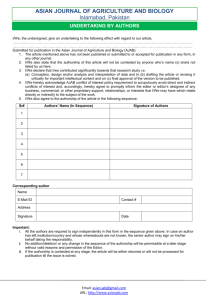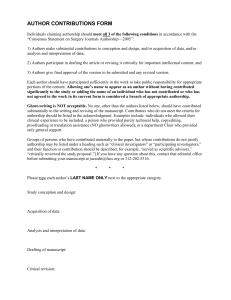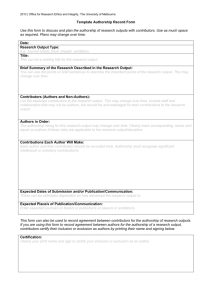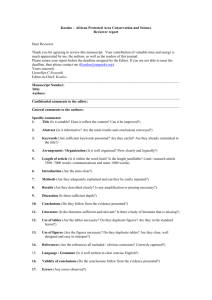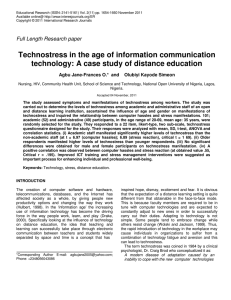Seminar 11
advertisement
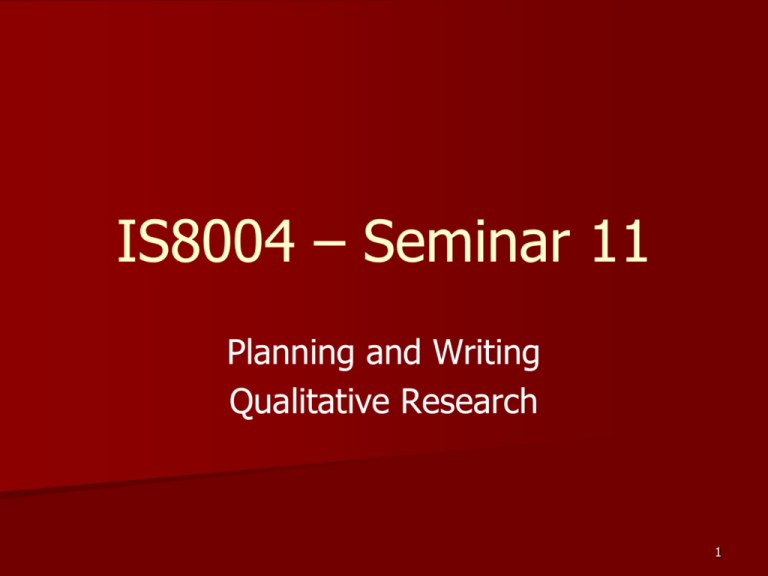
IS8004 – Seminar 11 Planning and Writing Qualitative Research 1 Recapitulation In previous classes we have looked at a variety of topics associated with the different aspects of qualitative research methods Each of those stands alone, yet we must also integrate them in a holistic research design 2 Research Planning and Writing Although planning and writing are two different activities, they are closely linked – so we will look at them together Each is critical – To a good research design – To a successful research outcome 3 Research Planning Motivation Research question(s) Selection of methods Selection of theory Source(s) of data Type(s) of analysis Nature of contribution 4 Motivation Within the first page of the Introduction, you must sell the research to a reviewer Ideally, the motivation has both practical and theoretical components Ideally, it is *not* just about filling a knowledge gap The motivation should be intrinsically interesting It needs to be precise, concise and accessible to a general reader – not an expert 5 Research Questions They have to follow and be linked to the motivation They need to be expressed very clearly Later on, you will need to explain how – you have collected the right data from the right people – you have analysed that data In order to answer the questions – And report on those answers in the conclusions 6 Selection of Methods Exactly which methods do you plan to use – and why? The justification for the choice of method is very important. It can’t be because you know that method better – or even because other people used the same method in a similar study. You need to say why this is the most appropriate method for this study. 7 Selection of Theory This also has to be done very carefully. There may be many suitable or possible theories, yet whichever one you pick, there has to be a good justification – Is it that the theory offers a new lens through which to view the phenomenon? – Does the theory enable, empower or enslave? You may have multiple theories – Exploratory, explanatory, predictive… 8 Source(s) of Data Where is the data going to come from? – It is easy to miss this, but if you can’t identify the source of data at the planning stage, perhaps, later on, you will not be able to collect data at all! – Teams, triads, dyads, individuals, or...? – Junior staff, middle managers, CxOs? – Connected or disconnected people? – Organisations – documents, archives, reports? – Secondary sources? 9 Type(s) of Data What is the data going to look like? – Interviews and conversations – Diaries – Focus groups – Participant observations (ethnography) – Non-participant observations (case study) – User generated texts 10 Type(s) of Data Analysis How do you expect to analyse the data? – Which techniques? Patterns Metaphors Semiotics – Which constraints? – Which software might you need to help you? Is it available? Can you get it? 11 Contribution What kind of contribution do you hope to be able to make? This relates to the research questions, the motivation, and the way you tackled the research. Ideally, there are theoretical and practical contributions. 12 Research Paper Writing Is it just about doing all the things that you planned – and writing up? Or,…? One key issue is integration – The text needs to be well integrated – The story needs to flow from start to finish – You need to use references appropriately Not heaps of references, but enough to show that you do understand the literature Recent references (last 5 years to present) 13 Writing – Sequence 1 It is sensible not to leave the writing to the end of the research But you may not be able to write the introduction first – and the abstract should be written last The literature review and methods sections can be written earlier – And they may change 14 Writing – Sequence 2 When you have results and can analyse them, then write them up and start to think about the analysis The introduction and conclusion may be the penultimate sections The references need to be written continuously – As you cite (or just read) something, note it down – It is much harder to locate reference details later – Keep complete reference details – and ideally organise them Many people use End Note, though personally I dislike it 15 Writing - Consistency It is critical that you are consistent in your writing and referencing style. It is very irritating to read a paper that has an inconsistent style. If you irritate a reviewer, you are asking to be rejected. Perhaps you think it a small thing, but you are not the reviewer! 16 Examples of Reference Styles [81] Q. Tu, K.L. Wang and Q. Shu, ComputerRelated Technostress in China, Communications of the ACM 48(4) (2005), 77-81. Tu, Q., K.L. Wang and Q. Shu. 2005. “Computerrelated technostress in China”, Communications of the ACM, vol. 48, no. 4, pp. 77-81. Tu, Q., Wang, K.L. and Shu, Q. (2005) Computerrelated Technostress in China, Communications of the ACM 48, 4, 77-81. 17 Consistency Consistency includes – Font – style and size, e.g. Times Roman 12 – Line and character spacing, e.g. single or 1.5 or double; full justification or ragged – Reference style, e.g. [11] or Davison et al. (2010) – US or UK spelling Use a single dictionary (set language) for the whole paper Use the appropriate dictionary for the journal style – Margins 1 inch all round or …? Gutter or even. 18 Identification Most journals expect that you do not identify yourself openly as the author in the paper So be careful when citing your own papers Some journals are happy for you to say “I” not “We” – especially if it is a single authored paper 19 Authorship It is a good idea to agree author sequence at the same time as you plan the paper – Who is the first/lead author? – Who is second, third, etc. This avoids arguments later! You might need to add an author later – All authors should agree on this Each author should make an *intellectual contribution* to the paper – This is an AIS code of research conduct requirement 20 Authorship Problems Some people like to add lots of authors, especially *famous* colleagues or supervisors – These famous people may not realise – They may not agree with the content of the research (yet their name is associated with it) Should a Research Assistant be an author – or an acknowledgement? The issue of contribution is paramount. 21 Authorship Problems As a conference chair (a few years ago) I decided to reject a paper – It had 4 authors – 1 student, 1 supervisor and 2 famous people The reject letter went to all 4 The famous people were surprised & unhappy – They did not realise that they were authors Later, the student author demanded that I change my decision – “How can you reject this paper authored by these famous people?”! What did I do? 22 Multiple Authors If there are too many authors, people wonder who did what – and who did nothing! How many is too many? – At CityU, we are discouraged from having more than 3. – The most I have seen is about 20. – The most where I have been an author is 7. 23 Authorship and You When you graduate, assuming you stay in academia, a hiring committee will look at your publications How many single authored papers? How many first author on multi-author papers? How many with/without your supervisor? You need to prove that you can work alone, as well as with others. 24 Planning Exercise For this exercise, you need to work in 2s and to plan a qualitative study based on one of the topics 15 mins to think about it, 5 mins to present 5-8 slides needed 25 Topics Customer satisfaction with ebanking Senior executive decision making in a manufacturing firm Ethical values of IT analysts Productivity of insurance agents Job satisfaction of management consultants 26
